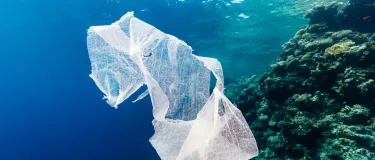Burst the marine litter bubble
As a pioneer in co-processing waste materials, Holcim continues to develop sustainable and innovative solutions that manage industrial and municipal waste. Under the Geocycle brand, our waste management specialists provide solutions for 10,000 customers in 50 countries, and do not stop to innovate in order for our technology and processes to be even more sustainable. With this spirit, Geocycle is piloting in India and France a non-invasive technology to remove plastic waste from rivers, preventing it from reaching the oceans.
Holcim is stopping ocean plastics
Eight million tons of plastic waste enter the oceans every year. Most of it comes from rivers and 90 of it comes from just 10 of them. At this pace the oceans will contain more plastic than fish by 2050.
Recognizing the need to address this challenge, Geocycle is partnering with CanadianPond to implement the ‘bubble barrier’, a non-invasive solution that stops plastic waste while letting ships and fish pass through.
How the bubble barrier works
Air is pumped into a special air tube that is placed diagonally on the river bed to form the bubble screen, thus bringing plastics to the surface and drives them to the riverside, where they will be collected and sorted. Non-recyclable plastics will be co-processed in our cement plants. This approach differentiates the Geocycle river clean-up from other projects that rely on landfilling or incineration for the collected plastic.
How Geocycle manages plastic waste sustainably
With its extensive network of facilities and specialists, Geocycle’s vast co-processing infrastructure treats non-recyclable plastics safely and sustainably. The Geocycle bubble barrier fits right in as a non-invasive system that captures plastics. A great opportunity to fight marine littering with a ‘zero-waste approach.
Co-processing is more sustainable than other solutions
Municipal waste is often landfilled despite a sizable proportion of it being ideal for further use. Sorting valuable recyclable material often results in a revenue stream for authorities rather than a cost. The remaining non-recyclable material is co-processed to reduce the amount of waste that ends up going to landfill, therefore reducing environmental impact and costs. Disposal in existing cement plants eliminates the need for the development of other controversial municipal landfill or incinerator projects.






